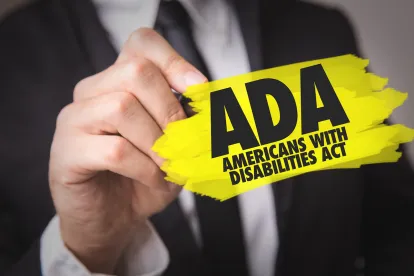Is your private sector company required by law to make its website accessible to individuals with disabilities? The answer depends on which judge you ask in which jurisdiction; different courts apply different tests. The result is a legal gray area where companies across all industries are forced to navigate uncertain waters that are churning with demand letters and lawsuits by plaintiffs’ attorneys.
On October 7, 2019, the Supreme Court declined an invitation by Domino’s Pizza to review a Ninth Circuit decision holding that Domino’s website and mobile app are required to be accessible to individuals with disabilities. Many were hoping the Supreme Court would provide clarity to the state of the law moving forward or inspire Congress or the Department of Justice to provide greater clarity via legislation or regulations. Unfortunately, those hopes have been dashed because the Supreme Court will not be taking up the case.
The State of the Law
The law that might require the website of a private sector company to be accessible is Title III of the Americans with Disabilities Act (ADA). ADA Title III applies to “places of public accommodation,” which generally speaking are private companies that offer goods and services to the public. For example, no one disputes that brick-and-mortar restaurants, retailers, hotels, hospitals and health care providers, other service providers, and similar entities are public accommodations. Under Title III, public accommodations must be accessible to those with disabilities.
There are specific laws and regulations detailing exactly what companies need to do to make their brick-and-mortar locations accessible and therefore in compliance with Title III. However, the same cannot be said for websites. It is unclear whether and which websites are subject to Title III, or what websites need to do in order to become sufficiently accessible, if Title III applies. The ADA does not mention websites nor are there regulations implementing Title III to websites. To make matters worse, there is mixed precedent in court as to whether and when a website is subject to Title III, and as to what that means, technically speaking.
Companies that offer goods and services online have faced a growing number of lawsuits in 2019. Plaintiffs’ attorneys are taking advantage of the uncertain state of the law, and they are sending demand letters and bringing lawsuits against companies all over the country, demanding settlement dollars and an agreement to make websites accessible. Many companies choose to settle these cases and make their websites accessible rather than litigate, including because: (1) litigation costs, litigation risks, and reputational harm can outweigh settlement and compliance costs; (2) accessibility may be required in the future, even if it may not be required now; and (3) accessibility can benefit both the company and individuals with disabilities. However, the uncertainty in the law is concerning and plaintiffs’ firms are exploiting it. Depending on a particular company’s circumstances, litigation may be preferable to settlement.
Rulemaking concerning website accessibility has been at a standstill. Under the Obama administration, the Department of Justice (DOJ) announced that it would propose such regulations. Under the current administration, however, DOJ withdrew that previous announcement. Although the current administration’s DOJ has issued a statement of its position that Title III applies to websites, that statement does not create law. Absent legislation or a unified national judicial approach (as could be provided by the Supreme Court), the waters will remain murky.
Petition for Certiorari by Domino’s Pizza
Domino’s Pizza’s petition to the Supreme Court sought review of the Ninth Circuit’s determination that Title III applies to Domino’s website and mobile app. The Ninth Circuit noted that the alleged inaccessibility of Domino’s website and mobile app impedes access to the goods and services of its physical pizza franchises — which were places of public accommodation. The Ninth Circuit held that the connection between the website and mobile app on one hand, and the physical restaurants on the other hand, were critical to its analysis, and stated that its decision did not decide whether the ADA covers websites or apps where their inaccessibility does not impede access to the goods and services of a physical location. Further, the Ninth Circuit held that Domino’s Pizza due process rights were not violated by this application of the ADA.
Erin Killeen also contributed as an author to this article.




 />i
/>i

